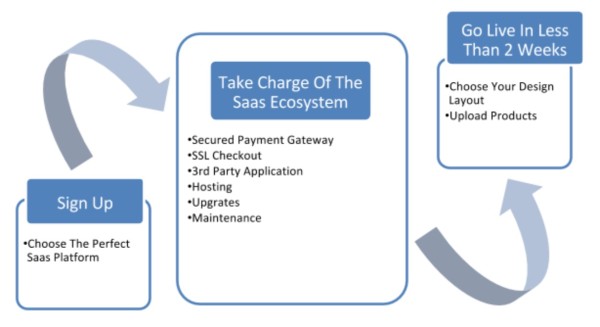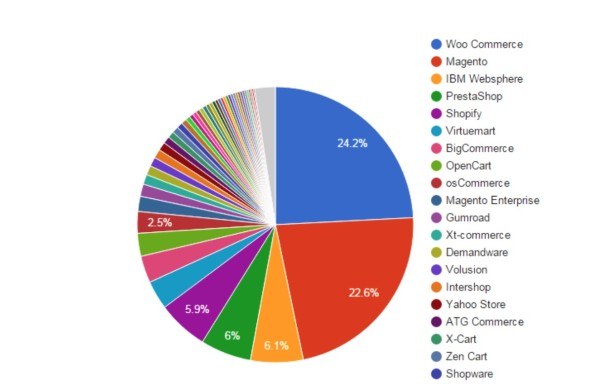In the last 20 years, the ecommerce business has changed the way we transact. We simply can’t deny the fact. The growing ecommerce trends and innovation have made it feasible for B2B and B2C sellers to reach a wider audience and market their brands better.
Open source ecommerce platforms had always been a leader until few years back, when SaaS based ecommerce platforms gained popularity and increased user-adoption, changing the face of ecommerce forever. This begs the question about the ‘state of open source ecommerce Platforms’ and how/if they’re survive the threats posed by the new and shiny SaaS options.
Also, digging deeper into the ecommerce platforms, we can see the stark difference in the adoption of open source ecommerce platform versus the SaaS ecommerce platforms.
The Face Of Ecommerce Platforms
(Courtesy – Datanyze)
More than 70% of ecommerce websites run on an open source platform, clearly highlighting that their popularity is still intact. But, on the flip side, there is no denying the fact that the SaaS platforms can catch up. Most paid ecommerce platforms are developing and releasing some very useful services – Some that even match up to open source platform services.
Why SaaS Ecommerce is Gaining Popularity
In the recent years, there has been an influx of entrepreneurs looking to make it big in the ecommerce industry. These SaaS platforms make it extremely easy for them to release their ‘beta idea,’ instead of investing time in creating a sustainable and robust ecommerce store.
The SaaS Ecommerce Structure
Let’s take a bird’s eye view on the complete SaaS ecommerce structure to understand it a little better.

The overview gives us a pretty clear picture on how easy it is to set up an online store using the SaaS platforms. If you already have a store and would like an online presence, then these SaaS platforms give you the perfect opportunity to do just that.
There is no need for any development skills, as one just needs to catalogue their products, create decent descriptions and then they are all set to sell online. The biggest challenge lies in marketing and gaining the online presence needed to get your products sold. But that’s whole other topic.
Even though SaaS has many third party integrations, it cannot be as SEO friendly and content oriented like an open source ecommerce platform. With SaaS platforms, you are limited to a certain number of templates and designs which hinders your brand creativity and the potential to be an awesome ecommerce store.
Why Open Source Will Always Be A Leader
Open source ecommerce platforms are robust and help create a sustainable and perfect online store, the way you want it.
Let’s take a complete look at the open source structure and define how it helps your ecommerce sales and strategies:

Creating an open commerce site is a lengthy process, mainly due to choosing the right open source technology and a reliable development firm – One that can build the perfect ecommerce store for you.
Talking to our customers who run ecommerce stores, we understand the different ways open source platforms have helped grow their ecommerce business. For starters, it is a great way to test the waters before you take the plunge. You can easily start small and expand the store seamlessly to meet your needs.
Also, when you choose open source CMS like Drupal Commerce or WooCommerce to host your store, there are limitless marketing opportunities. B2B and B2C companies benefit greatly with such CMSs as you can showcase relevant videos, images and appropriate description to convince buyers with facts and data. Such options are not as available in SaaS based ecommerce platforms.
Also, running on a SaaS platform proves to be expensive in the long run and when you do want to migrate to another platform, it will prove to be difficult. These two major factors make the open-source platforms as the knight in shining armor for entrepreneurs.
Challenges Faced In Open Source Ecommerce Platforms
The biggest problem in choosing an open source platform is that it is extremely difficult to start an online store if you are not a techie. The only way out is by hiring an open source ecommerce developer who can build your store.
Choosing the right ecommerce development firm proves to be difficult, as they should not only be open-source experts, but also have great designers who can create the perfect user experience that helps define your brand. This hiring process can prove to be extremely time consuming as you need to first identify the best developers and learn to trust them.
The second issue lies with the development time. Depending on the size of the store and the various features, it can take anytime between 3 weeks and 6 months to develop the complete site.
Even if it’s a time consuming, you need the required time to source your merchandise to set a robust ecommerce process. Even if SaaS platforms let you sell instantly, one cannot decide to start an ecommerce store and start selling the very next day.
Open Source Ecommerce Platforms Vs SaaS Ecommerce Platforms
| Open Source | SaaS |
The Pros:
|
The Pros:
|
The Cons:
|
The Cons:
|
Now that we have a clear understanding about the open source ecommerce platform and how the SaaS platforms might pose as a threat, let’s take a look at the following trends:

(Courtesy – Google Trends)
It clearly shows that there is a decline in the need for open source ecommerce platform. But, on the bright side, the need for the ecommerce SaaS platform is not anywhere close to being a serious threat. We can safely conclude that, currently, the need for open source platform remains intact and dominant.
Author Bio: Jeffrey Wisard is the Digital Content Manager at Drupal Partners. He writes about open source, Drupal Commerce developers and all things digital marketing. When he’s not thinking about content strategy, you can find him on his bike or run commuting home in Atlanta, GA. Follow him at @DrupalPartners.








Comments 0 Responses